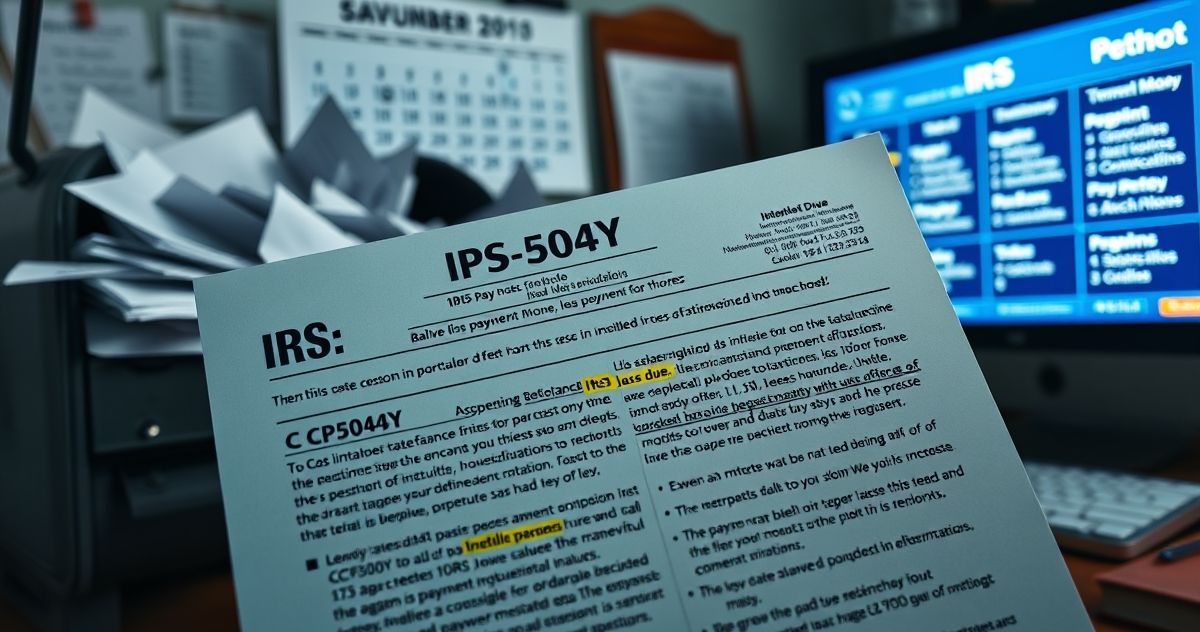Overview of the CP504Y Notice
The CP504Y Notice is an official communication from the Internal Revenue Service (IRS) designed to alert taxpayers to an existing tax debt that must be addressed immediately. This notice serves as a crucial step in the IRS tax collection process, acting as a final warning before the IRS takes more aggressive measures to recover unpaid taxes. Understanding the nature of the CP504Y Notice, its primary purpose, and the actions it demands is essential for taxpayers seeking to maintain financial compliance and avoid further complications.
Primary Purpose of the CP504Y Notice
The primary purpose of the CP504Y Notice is to inform the taxpayer that their tax account has an outstanding balance, and immediate payment is required to avoid enforcement actions. This notice not only details the amount owed, including any accumulated interest and penalties, but also warns of the impending consequences should the taxpayer fail to settle the debt. Receiving a CP504Y Notice indicates that earlier communications from the IRS, such as notices CP501, CP502, or CP503, have not resulted in payment or resolution.
Key Components of the CP504Y Notice
The CP504Y Notice includes several critical components that provide the taxpayer with necessary information to address the outstanding debt effectively. These components typically include:
- Balance Due: A precise breakdown of the tax liability, indicating the original amount, accrued interest, and applied penalties, resulting in the total amount now due.
- Payment Instructions: Detailed guidance on how the taxpayer can submit payment, including options for online payment, check, or money order. The notice will also include the address for mailing payments.
- Penalty and Interest Explanation: A description of how penalties and interest are calculated, reaffirming the importance of timely payment to minimize further costs.
- Consequences of Non-Compliance: A clear warning regarding potential enforcement actions, such as federal tax liens, bank levies, wage garnishments, or the offset of federal payments. The IRS may also levy state tax refunds.
Compliance Requirements and Next Steps
Upon receiving a CP504Y Notice, it is imperative that the taxpayer responds quickly to avoid escalated enforcement measures. Here are the steps a taxpayer should consider:
- Review the Notice Thoroughly: Ensure that all listed details are correct, including tax year and balance due. If discrepancies are found, contact the IRS immediately.
- Evaluate Payment Options: Assess how to clear the debt, either through immediate payment in full or by seeking alternative arrangements with the IRS. Options may include an installment agreement or an offer in compromise, depending on the taxpayer’s financial situation.
- Contact the IRS: If the taxpayer is unable to pay the full amount immediately, it is crucial to communicate with the IRS to discuss possible solutions before the enforcement actions are taken.
Penalties and Consequences for Ignoring a CP504Y Notice
Failure to respond to a CP504Y Notice can result in serious penalties and enforcement actions, including:
- Federal Tax Levy: The IRS may seize bank accounts, garnish wages, or take other assets until the tax debt is satisfied.
- Federal Tax Lien: A lien may be placed on the taxpayer’s property, affecting their credit score and ability to secure loans or sell assets.
- Offset of Federal Payments: The IRS can claim future tax refunds or other government payments to offset the debt.
These measures significantly impact one’s financial standing and highlight the urgency of addressing the notice promptly.
Importance and Significance of the CP504Y Notice
The CP504Y Notice is not only a demand for payment but also a vital step in the IRS’s collection process. It serves as a critical reminder of the taxpayer’s obligation to resolve outstanding debts, thus maintaining compliance with federal tax laws. Addressing this notice promptly can prevent more severe financial repercussions and aid in retaining a favorable financial status. In essence, the CP504Y Notice is central to the IRS’s efforts to enforce compliance and ensure taxpayers meet their responsibilities.
Taxpayers who receive a CP504Y Notice should view it as an opportunity to rectify their account status before escalating to legal measures. By taking the appropriate actions outlined in the notice, individuals can work towards a resolution that aligns with their financial capabilities, ensuring long-term compliance and financial health.

